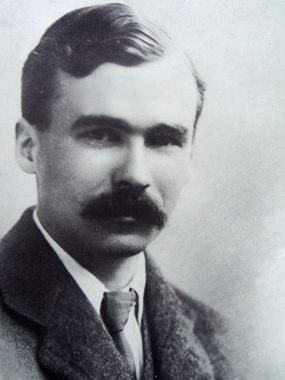Rivers of Life

George Butterworth
in 1914.
“A river,” wrote Laura
Gilpin, “seems a magic thing … a magic, moving, living part of the very earth
itself.” Now Laura Gilpin you might recall, was an indefatigable American
pioneer photographer remembered not only for her expressive portraits of Native
Americans, but also for her monochrome photographs of south-western landscapes.
As a child, her mother encouraged her to study music, and she even spent five
years at the New England Conservatory of Music. As it turned out, her musical
talent did not blossom as anticipated but instead she became one of the great
names in photography who in addition, became one of the finest exponents of
platinum printing.
In his short piece
River of Life, the Scottish poet Thomas Campbell wrote, “The more we live,
more brief appear our life’s succeeding stages.” Anyone over a Certain Age will
recognise a melancholic ring of truth in that. “Life is like the river,” Emma
Smith wrote; “Sometimes it sweeps you gently along and sometimes the rapids come
out of nowhere.” I suppose most of us have experienced that sort of thing.
Comparisons between rivers and life it would seem are hard to resist.
Battles have been fought
over rivers or at least, close to them. The Battle of the Somme was a horrific
and tragic episode during the First World War, involving British and French
troops against those of the German Empire. The battle began in July 1916 and
raged for over four months on both sides of the River Somme in France. By the
following November, over a million soldiers had been killed or wounded.
One of them was
31-year-old George Butterworth, a Lieutenant in the Durham Light Infantry who
had already been awarded the Military Cross for bravery. On 5th August
1916 in the muddy trenches near the river, he was killed by sniper fire. Few
other soldiers, including his commanding officer were aware that Butterworth was
one of the most promising young English composers of his generation.
George Butterworth (1885-1916): The Banks of Green Willow.
National Children’s Orchestra of Great Britain, cond. Roger
Clarkson (Duration: 06:34; Video: 480p)
Although he was born in
London’s Paddington district, the family soon moved to Yorkshire so that his
father could take up an appointment as General Manager of the North Eastern
Railway. The boy received his first music lessons from his mother and he began
composing at an early age, playing the organ for services in the chapel of his
elementary school. He won a scholarship to Eton College and later in life
became a close friend of composer Ralph Vaughan Williams.
The Banks of Green Willow
was written in 1913 and it’s a pastoral piece, based loosely on a folk song that
Butterworth heard and wrote down in Sussex. The title implies a musical picture
of a river somewhere in England, but we don’t know exactly where. The work is
given a lively performance by the National Children’s Orchestra of Great
Britain, a well-established organisation in the UK. Hearing these young
musicians playing with such commitment and maturity it is hard to believe that
they are all less than thirteen years old.
Like so much of the music
by Delius and Vaughan Williams, this work sounds utterly English. It’s a
picture of the England that Butterworth loved so much and for which, like so
many others, he fought for - and paid for - with his life.
Bedřich Smetana (1824-1884): Die Moldau.
Chamber Orchestra of Europe, cond. Nikolaus Harnoncourt
(Duration: 14:38; Video: 360p)
Unlike Butterworth’s
meandering English river, we know exactly where this one lies. Bedřich Smetana
is known today as the grandfather of Czech music because he pioneered a totally
national musical style.
Má Vlast,
meaning “My Homeland” is a set of six symphonic poems that Smetana wrote during
the 1870s and one of the movements is called Vltava, also known by its
German name Die Moldau. It describes the journey of the Vltava River
from its source in the Bohemian mountains through the countryside to the city of
Prague. The Czech name probably comes from an old Germanic expression wilt
ahwa, meaning “wild water”. The piece contains Smetana’s most famous
melody, an adaptation of a borrowed Moldavian folksong which is strikingly
similar to the tune of the Israeli national anthem.
Despite the slowish tempo,
this is one the most expressive recent recordings I’ve heard. It’s beautifully
timed and phrased with responsive playing from the orchestra. It starts with a
musical impression of two springs, with water bubbling out of the earth, which
eventually leads into the main theme. There are musical snapshots of a hunt in
the forest, a peasant wedding, water-nymphs in the moonlight, St John’s Rapids
and finally the concluding section in which the river triumphantly enters Prague
and then flows majestically away into the distance.

